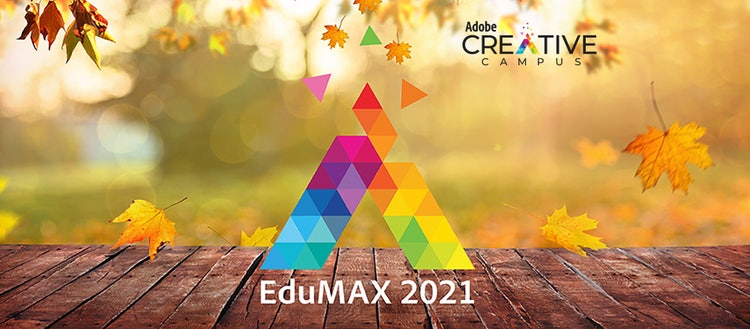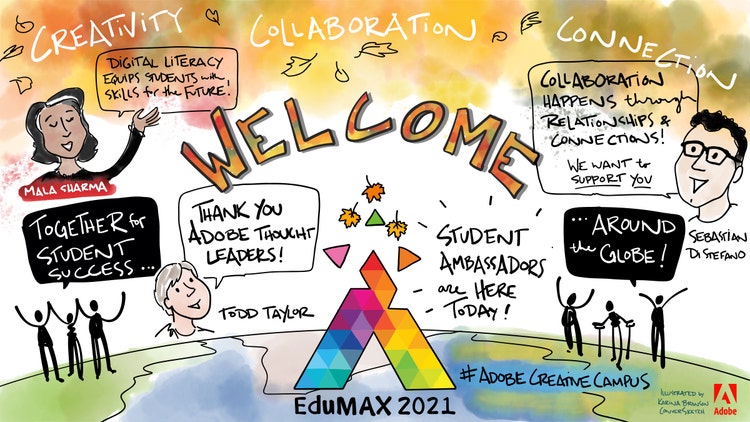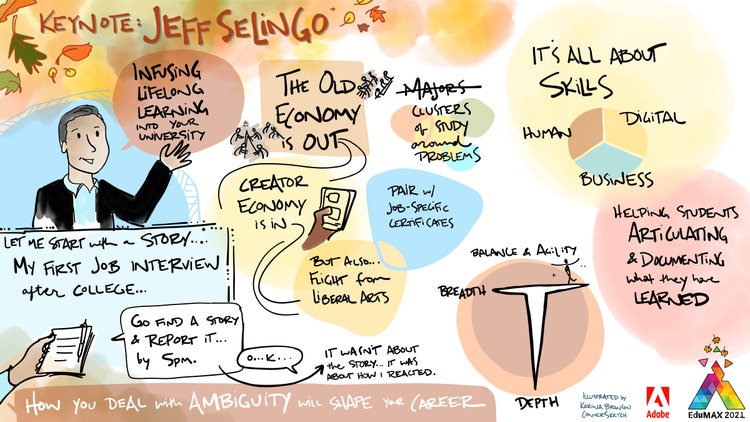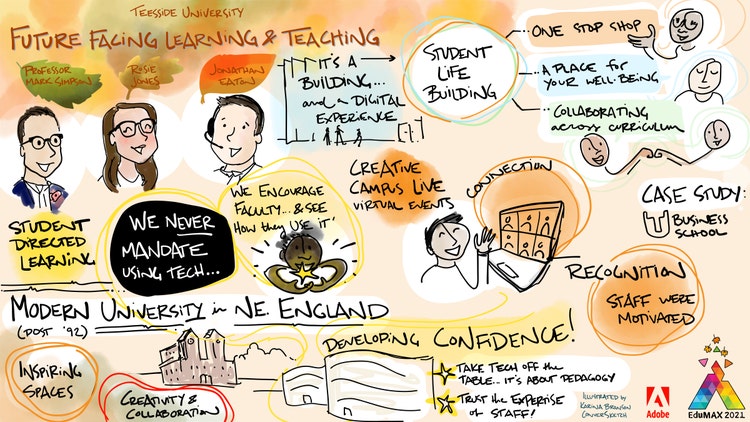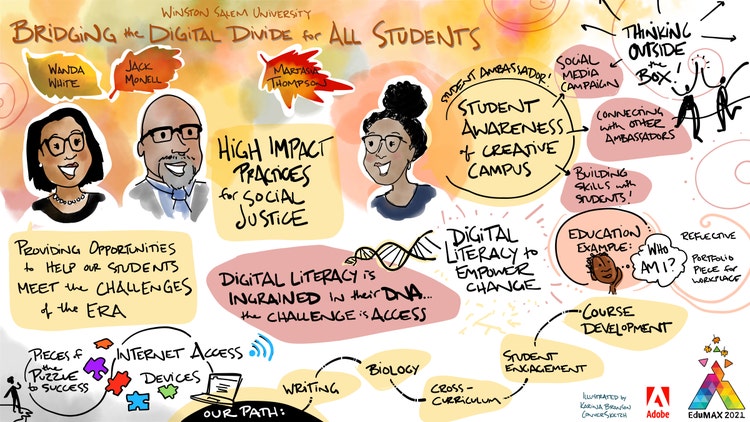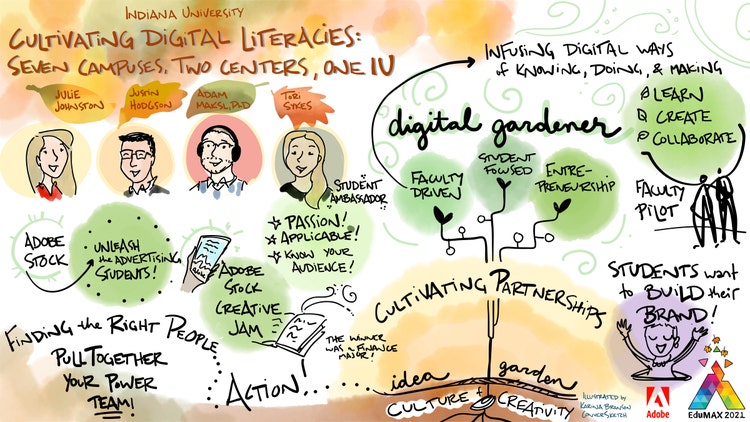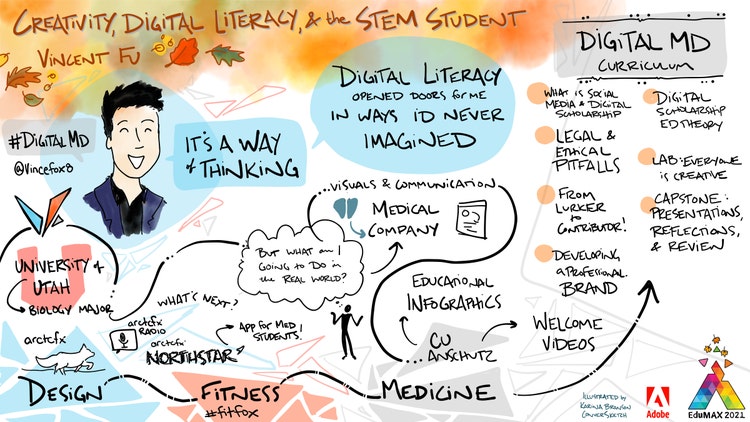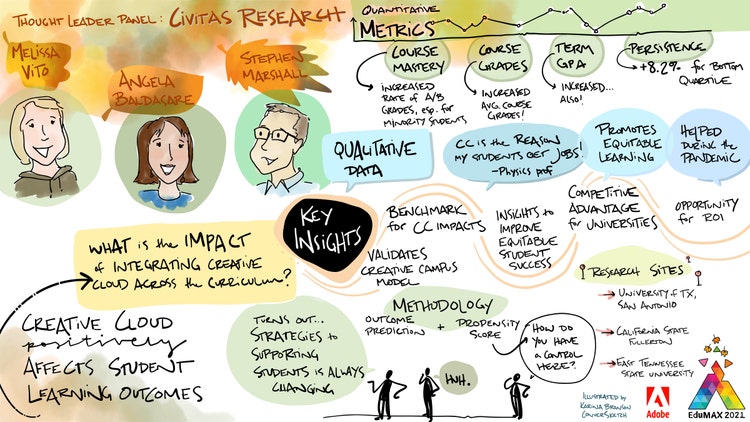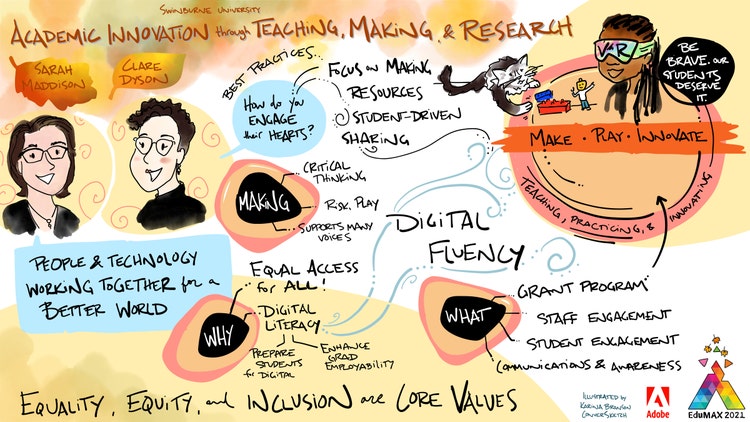COVID-19 continues to disrupt higher education on a global scale, challenging institutions to find ways to meet the needs of their students and faculty. While most colleges resumed in-person classes at the start of the current semester, the coronavirus pandemic irrevocably shaped the skills that matter most to students and the way students will learn.
University CIOs, deans, provosts, faculty and staff from more than 100 institutions convened online for the Adobe EduMAX 2021 conference, where academic leaders shared how they are transforming teaching and learning practices across their campuses. Key discussion points included:
- How digital literacy increases engagement to bring faculty and students together, whether they are in-person, online or in a hybrid environment.
- How digital literacy closes the skills gap in higher education and industry by fostering critical essential skills that employers value.
- How faculty can integrate digital literacy across the curriculum for all students.
This year marks the sixth anniversary of the first Adobe EduMAX conference that was hosted in a small room at the University of Southern California’s Annenberg School for Communication and Journalism. Since then, the Adobe Creative Campus program and EduMAX conference have grown substantially, with over 50 institutions now being recognized as Adobe Creative Campuses. The core theme of EduMAX 2021 explored how important a global perspective on higher education can be toward finding solutions to the challenges that we all share, as well as attending to the increasing global reach of Creative Campus institutions. I’m excited to share a few highlights:
The future of work and education: Continual learning in the digital economy
The keynote from journalist and higher education author, Jeff Selingo, kicked off EduMAX by examining how the future of work is driving colleges and universities to promote a culture of lifelong learning.
“Historically, we thought of school as something that happens to young people — we also thought of it as episodic — happening at different points in life,” Selingo said. “But now, learning is continual — much like the high school movement of the early 1900s and the college for all movement in the 1960s, we are at a moment in history where we must think that learning is always on.”
Compounded by the emergence of the “creator economy,” he described the greater demand for “ T-shaped individuals” in the workplace. While being a jack-of-all-trades may have been useful before, now more than ever, employers are looking for college graduates who can show depth and mastery in a particular area and also demonstrate their ability to adapt to uncertainty and confidently work across a variety of areas.
Technology’s impact on the world of work now requires employees to apply their breadth and depth of knowledge every day. Selingo underscored the importance of colleges showing their value by providing more opportunities for students and alumni to cultivate essential skills, such as digital literacy.
“Skills are the coin of the realm in this job market now and in the future, because they're both translatable and transferable,” he said. “That means no matter where you learn them, you can translate them to another context, from the classroom to a job, and no matter where you use them, you can transfer them to another job.”
Future-facing learning and teaching in the UK
Selingo’s keynote opened the door for Teesside University’s story in the UK as one of the newest members of the Adobe Creative Campus program. Like the keynote, professor Mark Simpson, pro vice-chancellor for Learning and Teaching, heralded the campus’ “future-facing learning” as identifying skills that faculty and employers wanted to see amongst students and staff, and then adapting curricula across academic disciplines to cultivate them.
With future-facing learning, Simpson and his team placed a greater focus on teaching excellence, creating inspiring spaces for students and faculty, as well as designing and delivering 21st century curricula to students. Teesside cultivated a faculty development program, where they learned how to use digital tools such as tablets and Adobe Creative Cloud across multiple surfaces, devices and contexts. Faculty then began innovating with these tools by encouraging students to collaborate with their peers and express their creativity.
Jonathan Eaton, academic registrar at Teesside, shared how his team deployed Adobe Creative Cloud in a business school course for first-term students during the pandemic. Students previously found the course to be difficult as it promoted project-based learning and required them to create a sustainable business model with mentorship from an academic advisor or member of the business community. However, with access to Adobe Creative Cloud, students felt increasingly more confident to express themselves and their ideas in more engaging ways, which ultimately helped them yield greater outcomes.
Bridging the digital divide for all students
Adobe’s digital literacy thought leaders at Winston-Salem State University (WSSU), Dr. Wanda White, director of the Center for Innovative and Transformative Instruction, and Dr. Jack Monell, associate professor and program coordinator of Justice Studies, reflected on the challenges their students initially experienced and ultimately overcame when transitioning to remote learning at the start of the pandemic.
White and Monell explained that although socioeconomic and geographic disparities impact student populations at all universities, nearly one-out-of-five students at WSSU come from households with an income of $25,000 or less, and many live in rural areas without access to pivotal resources for remote learning, such as high-speed internet.
“When students lack digital access, they are missing a piece of the puzzle to success, because everything that we do now has some type of digital component to it,” White said.
As the first Historically Black College and University (HBCU) to become an Adobe Creative Campus, WSSU has been committed to bridging the digital divide to empower students as well as staff. However, White knew that merely granting students access to Adobe Creative Cloud would not solve education inequities — the university needed to raise awareness of these offerings to help students develop critical digital literacy skills. To achieve this goal, WSSU launched an Adobe Student Ambassador program, which enabled students like Martasia Thompson, now an alumna of WSSU, to demonstrate how they learned to use Creative Cloud across various class projects and create their own career branding through tutorials and virtual, peer-led events.
“The most important benefit that I felt from this experience was seeing the impact that other students who didn't know they had that privilege [of having access to Creative Cloud], [which] is what contributed to that digital divide,” Thompson said. “Being able to spread the word of these products and make students aware of their access and find ways to connect the dots on how they can use the tools, whether they're an English major or a biology major, was super impactful.”
Her powerful experience as an Adobe Student Ambassador at WSSU prepared her for a post-graduate career as she was able to understand her target audiences and display her ideas in more compelling and creative ways. Thompson’s digital literacy skills ultimately helped set her apart when transitioning from her role as a marketing intern to a territory manager at Reynolds American.
Adobe & Digital Literacy
Build digital literacy at your school.
Learn more
Cultivating digital literacy across a multicampus institution
Promoting the adoption of digital tools across curricula is no small feat, especially for a multicampus like Indiana University (IU), which has more than 110,000 enrolled students across seven campuses located throughout the Hoosier State.
Julie Johnston, director of Learning Spaces/University Technology Services at IU, spearheaded the effort to familiarize the student population with Adobe Creative Cloud, in partnership with a team of IU faculty, staff, students and an Adobe customer success representative.
During interactive webinars throughout the pandemic, they demonstrated how students could leverage Adobe Stock across various academic disciplines to create more dynamic, professional-looking course work. As part of the session, they challenged student attendees to try Adobe Stock and use creative assets to tell a story.
Johnston shared how the program successfully engaged faculty, encouraging them to integrate Adobe Stock to display high-definition images in remote learning environments. For example, faculty members at IU Kokomo used MRI stock photos for medical imaging classes. In the last year alone, IU saw an increase of 3,800 users and licensed nearly 80,000 images on Adobe Stock.
Similar to WSSU, IU also found success with launching its own Adobe Student Ambassador chapter to drive active use of Adobe Creative Cloud across four of its campuses. Tori Sykes, a junior majoring in informatics at IU Bloomington, helped hundreds of her peers build digital literacy by teaching workshops on how to use Adobe Creative Cloud in all facets of their lives — from developing career portfolios and visual presentations on Adobe Spark to making GIFs on Adobe Photoshop for their social media feeds.
Student spotlight: Building creativity, digital literacy as a STEM student
As a former Adobe Student Ambassador at his alma mater, the University of Utah, Vincent Fu exemplifies how the program can put students on the path to success by helping them build essential skills such as creativity, collaboration and critical thinking — across all disciplines.
“Over the last few years, I realized that I don't just have to be a doctor or just have to be a design professional,” Fu said. “My whole professional career, thus far, is based upon digital literacy in a non-traditional field, so I embraced my talent for digital literacy and creativity in STEM.”
Fu shared how he honed and applied his digital literacy skills to build his professional brand as a creative in STEM. He is currently a fourth-year medical student at the University of Colorado — Anschutz specializing in emergency medicine. With his competitive edge and experience as a digital storyteller, Fu secured an opportunity to partner with a faculty member to teach an innovative curriculum on digital literacy in medicine. The course, which was titled Digital MD, prepares futures doctors for challenges of telehealth, social media engagement and public advocacy, which Fu acknowledged has been incredibly relevant during the COVID-19 era.
“Every single emergency medicine doctor that I've talked to about Digital MD gets really excited about the potential that this represents and how it could really revolutionize the way that medical students are being taught and how they go out into the world and into their careers,” he said.
Quantifying the impact of creative and digital literacy skills on student success
Ultimately, creativity and digital literacy empowers learning and unlocks more professional opportunities for students and new graduates.
A recent, first-of-its-kind study conducted by Adobe in partnership with Civitas Learning and LinkedIn measured the impact of integrating creative and digital literacy skills on student outcomes in school and their career trajectory post-graduation. The study demonstrated how the use of Adobe Creative Cloud in curricula improved course mastery — rates of As and Bs, course grades, term GPAs and retention — by examining student performance at the University of Texas San Antonio (UTSA), California State University Fullerton (CSUF) and East Tennessee State University (ETSU).
Dr. Angela Baldasare, principal consultant of Civitas Learning, Inc., sat down with Dr. Melissa Vito, vice provost for Academic Innovation at UTSA and Dr. Stephen Marshall, professor in Media and Communication & chief marketing officer of the ETSU Research Corporation, to discuss the research findings.
“I love the fact that this research highlighted something that people weren't looking at — this in a way, is even more important than what we know about tutoring and other types of academic support,” Vito said. “I think this serves as an example of how to think about the impact of a particular type of academic technology or support area.”
Fostering academic innovation and digital literacy
Faculty from Swinburne University of Technology, a research institution in Melbourne, Australia, wrapped up the EduMAX conference with a session about their efforts to engage students in dynamic learning, a method that can contribute to their success in and beyond the classroom.
To achieve this mission of fostering academic innovation and driving student engagement, Swinburne launched the Adobe Innovation Grant Program, which provided additional funds to help faculty to research, develop and teach new methodologies using Adobe Creative Cloud in their curricula.
Clare Dyson, associate professor of Digital Literacies at Swinburne, shared an example of a mathematics faculty member who developed a series of stop-motion videos using Adobe Premiere Rush, which analyzed algebraic concepts and helped students visualize math, something that can often be a challenge. The professor represented three-dimensional math problems with LEGO® models, which enhanced student engagement and improved their conceptual understanding.
“At Swinburne, we started having a robust discussion about what digital literacy means — having the skills to live, learn and work in a society where communication and access to information is increasingly occurring through digital technologies, internet platforms, social media and mobile devices,” said professor Sarah Maddison, deputy vice chancellor Education Employability & Experience at Swinburne. “Our aim is to support our students to creatively, confidently and critically use digital technologies in a global context in a variety of ways to search for information and to evaluate its authenticity and to digitally collaborate with others.”
As institutions evolve and the value of higher education is being rearticulated, all of the EduMAX speakers and thought leaders prompt us to focus on motivating students, helping them get the most out of their college experience and preparing them for tomorrow’s workforce.
For more information on how to integrate digital skills across disciplines and throughout curricula, please visit the Digital Literacy resources page. If you’re interested in learning how your college or university can become an Adobe Creative Campus to drive greater academic and professional success, please contact your sales representative.
